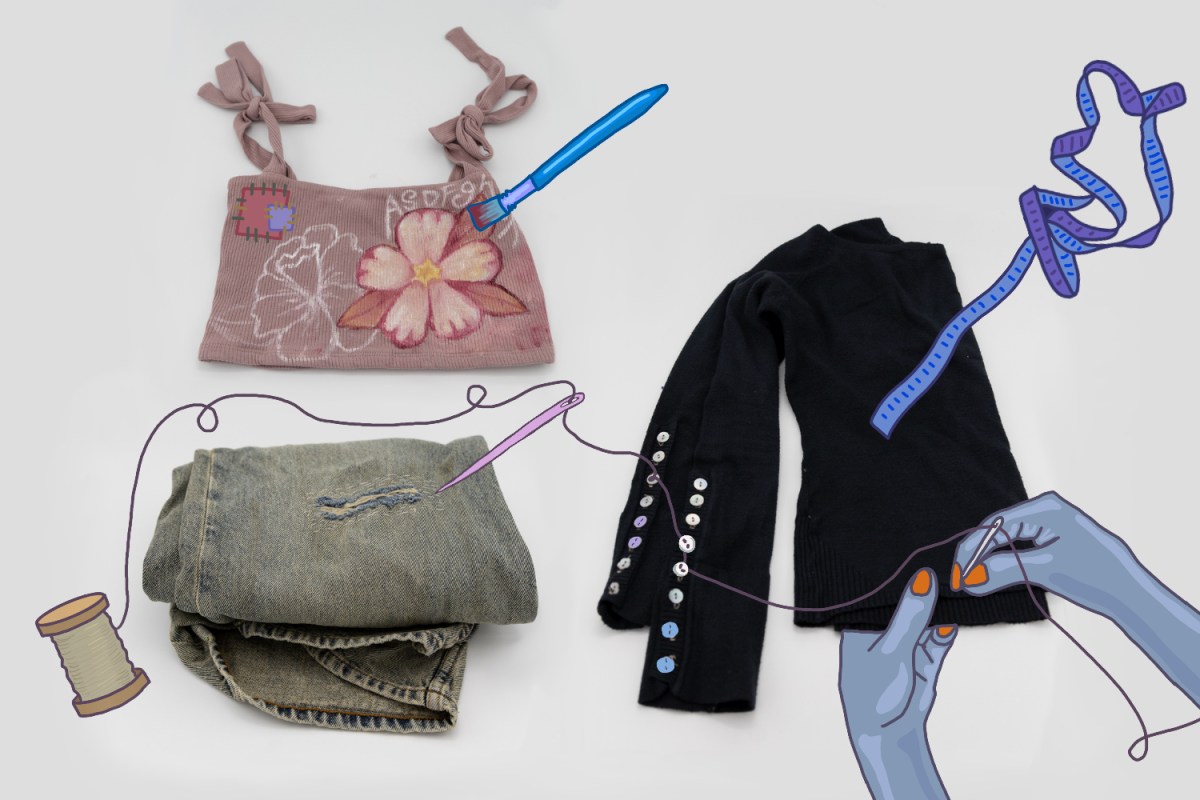In the summer of 2023, I began upcycling items in my closet to fulfill my desire for unique pieces without spending money on anything new. These personal projects manifested into a small business where I’ve had a lot of fun working with recycled materials. NYU is a very fashionable place, as our campus emulates the fashion-forward nature of New York City. I’m sure students want to have one-of-a-kind pieces in their wardrobe, and the most sustainable and cost-effective way to do that is to make them yourself. In an age of rampant consumerism, upcycling is needed more than ever — here are some tips and ideas for getting crafty with pieces you already have in your wardrobe
Fix a hole with visible mending
If you have any unwanted tears in shirts or rips in your jeans, instead of throwing the piece away or restoring it to its original condition, another option is to repair the visible flaws or snags in a way that makes a statement. There are various types of visible mending, such as slapping on a nice patch or doing a little embroidery. One visible mending technique I’m personally partial to is Sashiko, a Japanese technique which uses simple running stitches to create a pattern on top of the mended area. These can range from a square of simple dotted lines to intricate geometric designs. If you don’t want to sew a pattern by eyeballing it, a great technique for Sashiko is using a water-soluble transfer sheet where you can simply follow the stencil with your thread. There are a lot of options for sheets like this on Etsy, which will dissolve in the wash after you’ve finished stitching.
Use your clothes as a canvas
If you’ve got a boring article of clothing and at least a modicum of artistic talent, one way to spice it up is by painting on your clothes. All it takes is mixing a one-to-one ratio of acrylic paint and fabric painting medium. You can also just use fabric paint, but if you have acrylics I recommend taking advantage of the colors you already own and spending less money on heat-set fabric painting medium — I personally use Golden GAC 900. Once you’re ready to paint, you should put a piece of cardboard or any barrier between the front and back of your clothing to prevent bleeding. After your masterpiece is dry, just pop it in the dryer to set the paint into the cloth. Once the cycle is finished, your new work of art is ready to be washed like normal and seen in the light of day.
Take a trip to the NYU MakerSpace
If you’ve got a hankering to sew something, you may want to take a trip across the East River. Unless you’ve got a sewing machine in your room, a great free option you may not have heard of is the NYU MakerSpace on the university’s Brooklyn campus. If you’re willing to make the trek to the Tandon School of Engineering, all you have to do to use the sewing machines there is set up an appointment for training. There are three sewing-related training options available: Sewing for the use of the regular machine, embroidery and Industrial Sewing for a more heavy-duty machine that can handle thicker fabrics and faster sewing speeds. Once your training is done, you are free to use the space anytime between 10 a.m. and 10 p.m. on weekdays, and 12 p.m. and 6 p.m. on the weekends.
Harness the sun to lighten things up
Depending on where you live, changing the color of your clothes might be more or less of a challenge. Bleaching is a common way to make an article of clothing a lighter tone, and all it requires is a bottle of bleach and a water vessel that can fit your clothes. To lighten something up, mix a one-to-one ratio of bleach to water and soak your piece in the solution for five-to-10 minutes. After that, put your clothes out in the sun until they reach your desired color — just don’t leave the bleach in for too long or it will disintegrate the cloth. Once you’re done, rinse your clothes out in cold water to get all the bleach out, and then you can wash and dry them as normal.
Cook your clothes in dye
Is your closet looking a bit too cheerful for New York City? Did you thrift a cool piece only to realize you hate the color? You may want to dye it all black. In order to embrace your inner darkness — or dye a piece any color — all you need is a stove, a large pot and some cloth dye. The first step is heating up water on the stove at the highest setting. Once it’s quite hot, pour in some salt and soap to help with the dying process. For more synthetic fabrics, I would recommend adding some vinegar to the mix. Dyes can come in either powder or liquid form, so just pour whatever the recommended quantity is into your pot and stir well. Once the solution looks uniform, submerge your clothing into the water and leave it there for 30-to-60 minutes, stirring it regularly to make sure the dye is even. After soaking, rinse the clothing in cold water, making sure to get all the excess dye out. Keep in mind that the fabric will look darker before it goes through the washer and dryer — ideally by itself to avoid the dye transferring onto other items.
For the sake of the environment, I encourage you to make do with what you have, especially if that involves being creative. Instead of spending money on something new, you can transform a piece of clothing you already have into a wearable work of art. Regardless of your artistic abilities, there’s an upcycling option out there that can work for you.
Contact Isabela Fitzgerald at [email protected].























































































































































